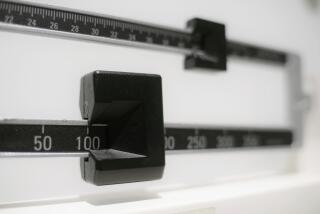Powerful Mind Tool Studied by Scientists : Visualization Technique Helps Some Dieters ‘Think Themselves Thin’
- Share via
The age-old maxim, “If you can think it, you can do it” is no figment of the imagination. Studies by prominent U.S. scientists indicate that you really can think yourself thin, active, successful--or whatever you long to be--through a powerful mind tool called visualization.
This technique can help you tremendously in your weight-loss efforts. If you can imagine yourself following proper nutritional guidelines, and engaging in various types of aerobic exercise, you can put those thoughts to work to boost your energy and enhance your overall health.
Cancer patients use visualization to activate the body’s immune system to speed healing, while migraine sufferers use their imaginal powers to control the frequency and severity of attacks. Studies show that athletes who practice visualization make great strides in performance.
Just as peak performers reap the benefits of visualization, so can you. Imagine yourself at the body weight at which you would feel most healthy, active and alive. Exercise the control center for images in your brain. Use your mind’s eye to create the image you want, then put your body’s neuromuscular system to work to acquire your body image.
A visualization program is an important tool in successful weight-loss or maintenance programs. The steps are simple, concise and fun, and requires only three to 10 minutes to perform. Provided you concentrate fully, the process will help you feel relaxed so you can focus on your goal weight. Remember, you are in control.
Getting Ready
Step 1. Choose a time when you can be alone. At home, find a quiet place where you won’t be disturbed; at the office, close your door and hold your calls. Choose a chair in which you can comfortably sit with both feet flat on the floor, arms on armrests and your shoulders completely relaxed.
Step 2. Focus on a point directly in front of you, and look slightly upward. Keep your mind on that focal point, concentrating fully on it, not allowing your mind to wander. Repeat to yourself: “I will focus completely on that spot.”
Step 3. Take a deep breath and count to yourself: “One thousand, two thousand, “ Exhale, counting again, “one thousand, two thousand.” Continue this process for three to five minutes. Allow any intrusive thoughts to pass by without judgment; simply let the thoughts go. You will begin to experience a feeling of heaviness, particularly in your eyelids. Allow them to close and continue to focus on deep, steady breathing.
Step 4. Once you have quieted your mind, scan your body for stress and tension caused by muscular contractions. Start at the top of your head and move down to the tip of your toes. Imagine yourself on a fantastic journey as you move through the muscles of your forehead, cheeks, lips, jaws, neck, shoulders, arms, back, abdominals, buttocks, thighs, calves, feet and toes.
As you move through each muscle group, tell yourself, “I release any and all stress and tension from this area. Allow yourself to experience a feeling of warmth and relaxation as you focus on freeing yourself of muscular contractions and increasing blood flow to a specific area.
Step 5. Visualize a scene in which you feel most relaxed and can concentrate on your body image goal. Here is a good example for you to try:
Imagine yourself alone in an exercise room. There are mirrors on every wall and a walking track in the middle of the room. You are dressed in comfortable exercise clothing, and you can see yourself in the mirror. Your body image is very appealing to you, and you feel attractive, active and alert.
You engage in some stretching exercises before beginning a brisk walk or run around the track. Focus clearly on your mental exercise room and feel your muscles as they begin to move. Continue walking or running until you have reached your imaginary predetermined number of laps. Then allow yourself a cool-down period. Now look in the mirror and visualize a confident and strong person who has a positive self-image.
Step 6. Fade the scene out as you hold onto the experience you have imagined, then count to three.
One: “I feel very confident in my commitment to my body image goal.”
Two: “I feel challenged by my visualization activity and will repeat it several times a day.”
Three: “I have complete control over my feelings, thoughts and behavior concerning my body composition and body image.”

